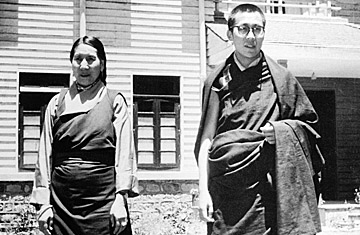
May 28, 1959: Tenzin Gyatso, the 14th Dalai Lama, and his mother, shortly after the Tibetan Buddhist ruler fled his homeland for exile in northern India
(6 of 9)
But the Dalai Lama was still too young to govern, and his state was run for him by regents. Two of them quarreled, and Lhasa was rocked by a brief civil war in 1947, in which howitzers were used to end the defiance of the monks of Sera lamasery. More important to Tibet and the Dalai Lama was another civil war: that in China. As Chiang Kai-shek's Nationalists were driven from the mainland to Formosa, it was inevitable that the Reds would soon attempt to assert the Chinese suzerainty that had been largely ineffectual for nearly 40 years.
In 1950 the test came. When a Red Chinese "liberation" army was poised on the Tibetan frontier, the nomad Khamba tribesmen asked Lhasa if it intended to fight. The Dalai Lama's advisers could not make up their minds. The fortress of Chamdo surrendered with scarcely a shot fired, and the Khambas decided that Lhasa had lost its nerve, and made no move to stop the Reds.
The young Dalai Lama was seldom consulted in such matters. He passed his time in study and in a new absorption in Western gadgets. He took many photographs, often wandered on the terraces of the Potala armed with a telescope with which he could examine the busy life of his city without ever being permitted to join in it. Each spring he traveled in solemn procession through ranks of bowing, weeping people to the summer palace; each autumn he solemnly returned to the Potala. The Austrian Harrer tutored him in Western science and technology, found in the Dalai Lama an insatiable urge for learning, a fascination with modern matters such as the construction of jet planes, but a total acceptance of his own godhead. Once, remarking on his previous incarnation as the 13th Dalai Lama, he said musingly: "It is funny that the former body was so fond of horses and that they mean so little to me."
As the Red Chinese pushed toward Lhasa, the Tibetan National Assembly sent an urgent plea to the United Nations for help against the aggressors. It was rejected with the pious hope that China and Tibet would unite peacefully. The uncertain Tibetan government called on the State Oracle to decide what the Dalai Lama should do. He urged flight.
Before leaving Lhasa, the Dalai Lama was hastily invested with full power as the ruler of Tibet and the regency abolished. In command of his country for the first time, just as it seemed on the point of dissolution, the Dalai Lama withdrew to the Indian border but did not cross over. Since it was clear that no power on earth was interested in aiding Tibet, the God-King opened negotiations at a distance with Red China. In May 1951, a 17-point agreement was signed between the two nations: Red China agreed that Tibet could retain autonomy and promised no change in the Dalai Lama's status, function or power. Tibet surrendered control of its foreign relations to Red China.
